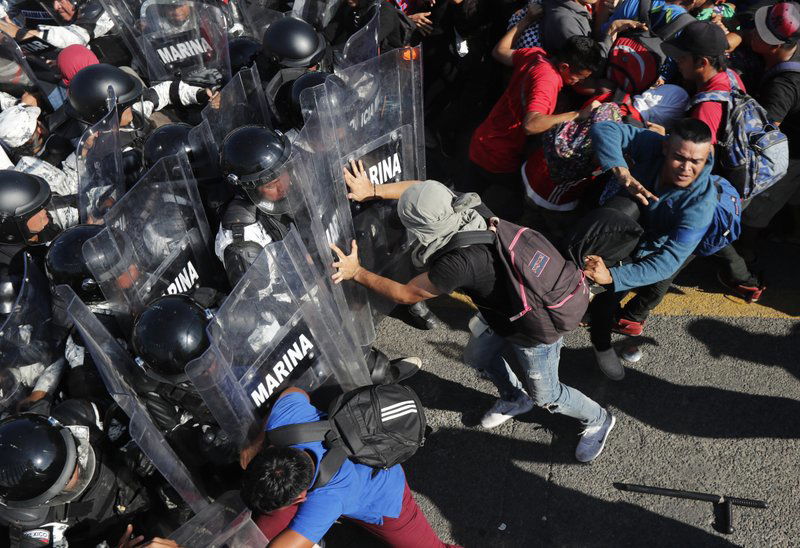Over 2,000 Central American migrants try to enter Mexico

TECUN UMAN, Guatemala (AP) — More than 2,000 Central American migrants on Saturday surged onto a bridge spanning the Suchiate River between southern Mexico and Guatemala as Mexican National Guardsmen attempted to impede their journey north.
Mexican authorities closed the bridge after the migrants tried to push their way across. The bridge was open on the previous day to migrants who wanted to cross and request asylum in Mexico, or seek to regularize their status and find work.
As the crowd swelled, amid shoves, Mexican officials allowed several dozen migrants to enter the country via the bridge, while a voice over a loudspeaker warned migrants against trying to slip into Mexico without passing through immigration filters.
Nearby, hundreds of guardsmen lined the river to prevent migrants from crossing into Mexico clandestinely. The voice on the loudspeaker warned, over and over, that those aiming to transit through the country may not be granted asylum in the U.S., even if they make it there.
Mexico’s government has said migrants entering the country without registering will not be allowed to pass from its southern border area. But those seeking asylum or other protections will be allowed to apply and legalize their status in Mexico.
Guatemalan officials have counted roughly 3,000 migrants who registered at border crossings to enter that country in recent days, and estimated there were an additional 1,300 migrants who did not register.
Vicente Hernández, head of the Mexican armed forces in the border area, told migrants standing across a barricade on the Guatemalan side of the border that “there are opportunities for everyone” in Mexico.
“Here you just have to register,” he added, saying that Mexican officials would then offer the migrants jobs.
Mexico’s offer of legal status and potential employment for migrants carries a stipulation that would confine migrants to southern Mexico, where wages are lower and there are fewer jobs than elsewhere in the country.
A Mexican official who asked not to be named said those who request asylum in Mexico are brought to one of two migratory stations in the state of Chiapas - one in Tapachula and the other in Tuxtla Gutiérrez.
Once there, in theory, the migrants may request temporary work permits to remain in Mexico. For months, however, non-profit organizations and migrants have complained that the migrants are instead often returned to their countries of origin.
Also, many of the migrants aim for a new life in the U.S. - not in Mexico.
“We are going to walk all the way up,” said Salvadoran Jazmín González, 23, while clutching a small girl.
González said she feared being deported as she turned herself over Saturday to Mexican authorities, alongside her daughter and three other family members.
Honduran Lourdes Geraldina Jiménez also decided to trust in the assurances of Mexican authorities as she entered Mexico with a son and another family member.
Jiménez said she left Honduras because gang members wanted to kill her 14-year-old son.
“I can’t return to Honduras,” she said, walking next to her son.
Many of the migrants leaving Central America say they fear for their lives back home, while others say they are looking for better economic prospects.
As temperatures rose Saturday, migrants trickled back across the bridge to Guatemala.
Meanwhile, Guatemala’s human rights defender’s office said there were more than 1,000 migrants gathering at another point on the Mexican border far to the north in the Peten region. There were reports that Mexican forces were gathering on the other side of the border there.
In the Mexican border town of Ciudad Hidalgo, Francisco Garduño, commissioner of Mexico’s National Immigration Institute, was emphatic that migrants who try to enter the country irregularly would go no farther.
“They cannot enter because it would be in violation of the law,” he told The Associated Press. He declined to talk specifics about border reinforcements, but said there were “sufficient” troops to keep things orderly.
___
Associated Press writer Sonia Pérez D. in Guatemala City contributed to this report.